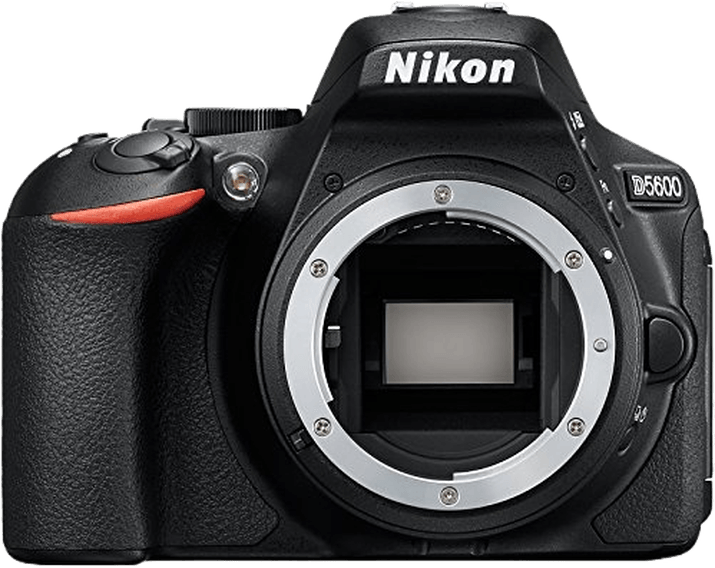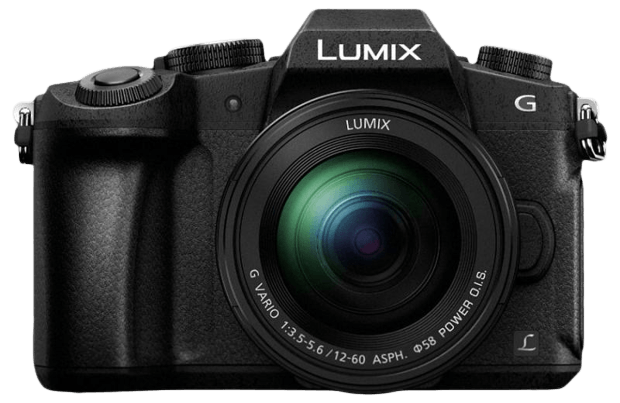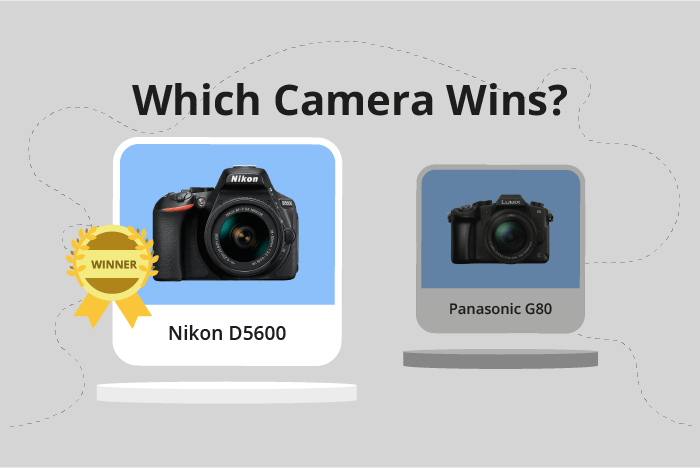Nikon D5600 vs Panasonic Lumix DMC-G80 Comparison
Nikon D5600

Panasonic Lumix DMC-G80

The Nikon D5600 emerges as the winner in our comparison, scoring 66/100, while the Panasonic Lumix DMC-G80 scores 58/100. Both cameras were released in 2016, with the D5600 being a DSLR and the G80 a mirrorless type. They share similar dimensions, with the D5600 measuring 124 x 97 x 70mm and the G80 at 128 x 89 x 74mm.
The Nikon D5600 has an advantage in terms of weight and price, weighing 465g and costing $700 at launch, compared to the G80’s 505g and $900 price tag. However, the Panasonic G80’s mirrorless design offers a more compact form factor, which some users might prefer.
While both cameras offer great features, the Nikon D5600 wins this comparison due to its higher score, lower price, and lighter weight. The Panasonic G80, though, is still a solid option for those who prefer a more compact camera.
Nikon D5600 vs Panasonic Lumix DMC-G80 Overview and Optics
The Nikon D5600 wins in the optics comparison with a score of 65/100, while the Panasonic Lumix DMC-G80 scores 57/100. Both cameras have a CMOS sensor and similar shooting speeds, with the D5600 at 5 frames per second and the G80 at 9 frames per second. They both also have different lens mounts, with the D5600 using the Nikon F DX and the G80 using the Micro 4/3.
The Nikon D5600 has a higher megapixel count at 24.2, compared to the G80’s 16 megapixels. This means the D5600 can capture more detailed images. Additionally, the D5600 has a higher DXOMARK sensor score of 84, compared to the G80’s score of 71, indicating better overall image quality. The D5600 also has a larger sensor size with an APS-C sensor, compared to the G80’s Micro Four Thirds sensor, which contributes to its superior image quality.
On the other hand, the Panasonic Lumix DMC-G80 has built-in image stabilization, which the Nikon D5600 lacks. This feature helps to minimize camera shake and produce sharper images, especially in low-light conditions or when using slower shutter speeds. The G80 also has a different aspect ratio of 4:3, compared to the D5600’s 3:2 aspect ratio, which may be preferable for some photographers.
In terms of optics, the Nikon D5600 outperforms the Panasonic Lumix DMC-G80 due to its higher megapixel count, larger sensor size, and better DXOMARK sensor score. However, the G80’s built-in image stabilization and different aspect ratio might be advantageous for certain users. Ultimately, the choice between these two cameras depends on individual preferences and photography needs.
Nikon D5600 vs Panasonic Lumix DMC-G80 Video Performance
The Nikon D5600 outperforms the Panasonic Lumix DMC-G80 in video capabilities with a score of 70/100, while the Panasonic Lumix DMC-G80 scores 56/100. Both cameras have some common specifications, such as a maximum video resolution and time-lapse functionality.
The Nikon D5600 and Panasonic Lumix DMC-G80 differ in their maximum video resolution and dimensions. The Nikon D5600 offers Full HD resolution with dimensions of 1920 x 1080, while the Panasonic Lumix DMC-G80 has a 4K resolution with dimensions of 3840 x 2160. Moreover, the Nikon D5600 has a higher maximum video frame rate at 60fps compared to the Panasonic Lumix DMC-G80, which has a maximum frame rate of 30fps. The Nikon D5600 also has built-in time-lapse functionality, giving it an advantage over the Panasonic Lumix DMC-G80, which lacks this feature.
The Panasonic Lumix DMC-G80, despite its lower score, has a better maximum video resolution (4K) compared to the Nikon D5600 (Full HD). This higher resolution allows for more detailed and sharper video footage. However, this advantage is offset by the lower maximum frame rate and the absence of built-in time-lapse functionality.
Given these differences, the Nikon D5600 is the better choice for users who prioritize video capabilities. Its higher frame rate, built-in time-lapse functionality, and overall higher video score make it a more versatile camera for video recording. The Panasonic Lumix DMC-G80, while having a higher video resolution, falls short in other areas and is less suitable for those who prioritize video performance.
Nikon D5600 vs Panasonic Lumix DMC-G80 Features and Benefits
The Nikon D5600 emerges as the winner in the features comparison with a score of 72/100, while the Panasonic Lumix DMC-G80 trails closely behind with a score of 70/100. Both cameras share several specifications, including touchscreen capability, flip screens, a lack of GPS, and WIFI connectivity. However, there are notable differences that contribute to the Nikon D5600’s higher score and advantages over the Panasonic Lumix DMC-G80.
One of the Nikon D5600’s advantages is its larger screen size of 3.2 inches, compared to the Panasonic Lumix DMC-G80’s 3-inch screen. This difference allows for better image preview and easier camera control. Additionally, the Nikon D5600 features Bluetooth connectivity, which the Panasonic Lumix DMC-G80 lacks. This provides users with an additional option for transferring images and remotely controlling the camera.
On the other hand, the Panasonic Lumix DMC-G80 has a slightly higher screen resolution of 1,040,000 dots, compared to the Nikon D5600’s 1,037,000 dots. This marginally higher resolution offers a slightly clearer image preview. However, this advantage is minimal and may not significantly impact the overall user experience.
Considering these differences, the Nikon D5600’s larger screen size and Bluetooth connectivity contribute to its higher feature score and make it a better choice for users prioritizing these specifications. The Panasonic Lumix DMC-G80’s marginally higher screen resolution offers a minor advantage, but it may not be enough to sway users away from the Nikon D5600’s other benefits. Therefore, the Nikon D5600 stands out as the superior camera in terms of features.
Nikon D5600 vs Panasonic Lumix DMC-G80 Storage and Battery
The Nikon D5600 outperforms the Panasonic Lumix DMC-G80 in storage and battery, scoring 43/100 compared to the G80’s 21/100. Both cameras have one memory card slot and accept SD, SDHC, and SDXC cards. However, the D5600 is UHS-I compatible, providing faster data transfer.
The D5600’s battery life is significantly better, with 970 shots per charge compared to the G80’s 330 shots. The Nikon uses an EN-EL14a battery, while the Panasonic uses a Lithium-ion battery. Neither camera offers USB charging.
Although the D5600 has a better score and longer battery life, the G80 still provides adequate storage options and battery life for casual users. When considering storage and battery, the Nikon D5600 is the clear winner, but the Panasonic Lumix DMC-G80 remains a viable option for those with less demanding requirements.
Alternatives to the Nikon D5600 and Panasonic Lumix DMC-G80
Are you still undecided about which camera is right for you? Have a look at these popular comparisons that feature the Nikon D5600 or the Panasonic Lumix DMC-G80:

